Do you own sheep or have a friend who does? If so, this highly profitable homestead side hustle might be just what you have been looking for to make money off your land or small farm. Cleaned raw wool sells for about $25 a pound.
Dyed wool roving typically demands a price of at least $5 for only a few ounces. The dyed wool roving is often sold to fabric artists, and used to make needle felted animals, wet felting play mats, and beautiful home decor.
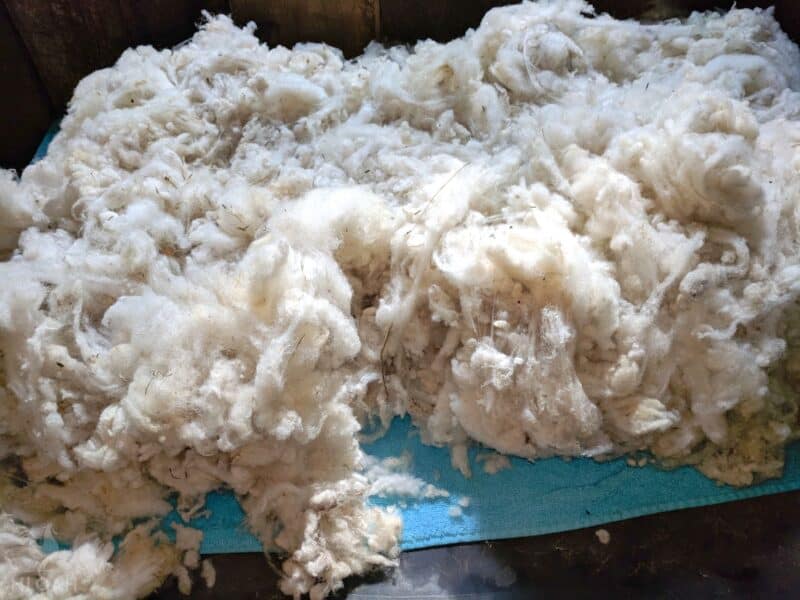
What Can You Do With Wool?
Raw wool is used to create Waldorf dolls and soft sculpted animals. These simple yet beautiful fabric dolls and animals commonly sell for $100 to $500 each.
Fiber artists use only natural materials to make the dolls, stuffed toys, and needle felted animals, and wet felted playscapes – and are willing to pay a handsome price for quality materials dyed in a low tox manner provided by homesteaders just like you instead of commercially manufactured items that are mass produced and infused with chemicals.
If you are the crafty type, you could learn how to make your own Waldorf dolls via our New Life On A Homestead tutorial with free patterns, stuffed toys, needle felted animals that sell for roughly $25 to $50 each or wet felted playscapes that run between $100 to $185 each, and make even more money from your homestead using the wool the sheep provide.
- This needle felted bear sells for $125 on Etsy.
- This wet felted playscape sells for between $99 to $147 on Etsy – depending upon the inclusion of the little needle felted animals shown in the feature display photo.
If you learn how to make a Waldorf doll after watching our tutorial videos and viewing the step by step photo guide, you could sell an unfinished head (wool head shape with or without a nose only) for about $25 to $50 each.
Raw Wool Cleaning Basics
Cleaning and dying wool is neither difficult nor expensive. While the process is a little time consuming when cleaning a big batch of dried wool all at once, it is not a labor intensive process, and can be completed easily even if you are an off grid homesteader.
To reduce the amount of time it takes to clean raw wool, wash and brush the animals before removing it.
Pretty up the sheep just like you are getting ready to take them to the county fair, and you will not have to spend a half an hour or more picking out briars, bugs, burrs, straw, and clumps of dirt from the raw wool after shearing.
Using electrical shears will speed up the removal process immensely as well, but you can also get the job done equally well with old-fashioned manual sheep shears.
Building a sheep shearing stand out of wood, or buying a metal one will also make the wool removal process much less frustrating – or use a goat milking stand.
If you can, learn how to shear from an experienced shearer who can show you how to get most of the sheep wool in one cut without having to go back for second cuts.
It takes a long time to figure out how to shear properly, but working with a high-quality wool breed that produces great wool (like merino wool) can help.
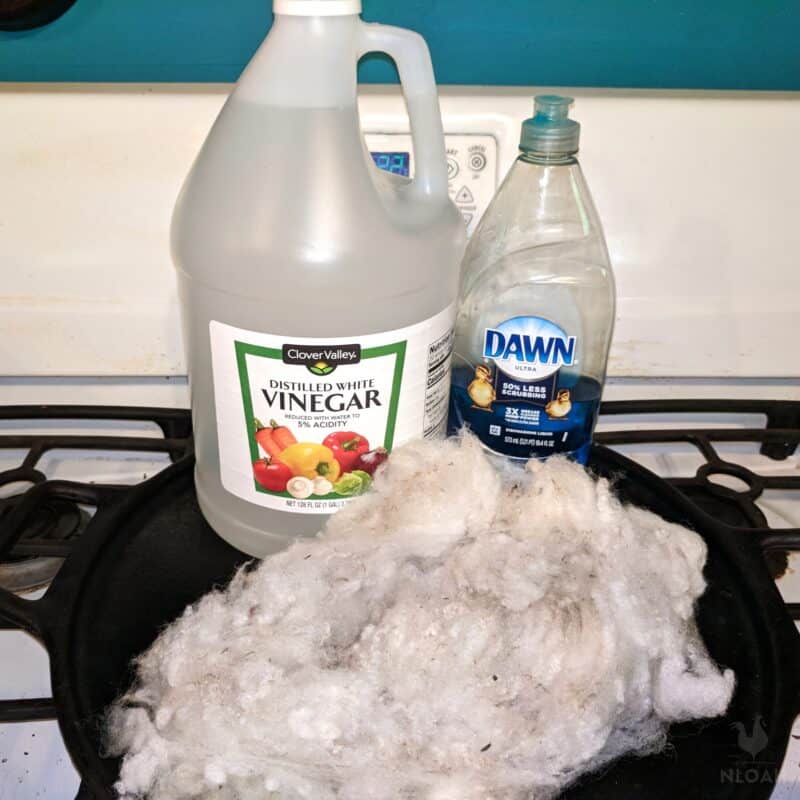
How To Clean Raw Wool
Washing raw wool (often referred to as scouring) removes dirt, straw, and wool grease – lanolin from the sheep fleece. Here are some recommendations for how to do it right…
It’s essential to remember that exposing raw wool to heat and too much agitation will cause it to “felt”. While getting the wool wet and pliable is vital to the wet felting craft process, doing so during the cleaning stage will ruin it for future use.
Felting makes wool items tough to work with and you can’t turn back once this has happened.
The key to cleaning wool properly is getting the heat levels just right and only manipulating or agitating the fleece as little as possible so it remains in its natural state. To avoid wet felting your wool while scouring it, never place it directly under running water and keep the water temperature lukewarm or warm and never – ever, hot.
You’ll have to hand wash and wring the wool repeatedly, so this is a time-consuming and laborious task, but trust me when I say it’s worth it!
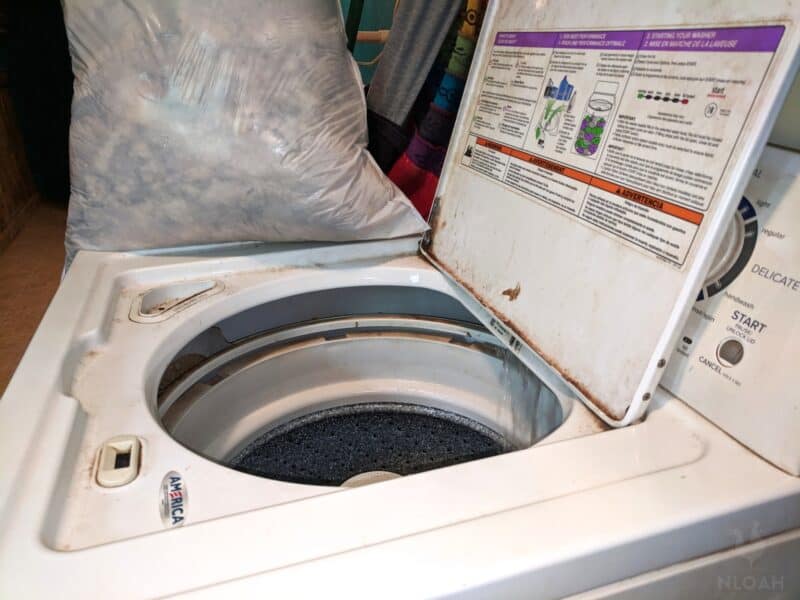
Supplies
- Raw Wool
- Distilled White Vinegar
- Liquid Dish Soap – Blue Dawn recommended
- Sink, bucket, wash tub, plastic tub, or clothes washer
- Warm Water
- Measuring Spoons
- Drying Rack or Towel
Directions for Large Batch Raw Wool Cleaning
Step 1: Fill a top-loading washing machine with warm water. If your washer only runs hot or cold, fill half of the washer with cold water, switch to the hot water setting, and manually agitate the drum for a few moments to mix the hot and cold water together.
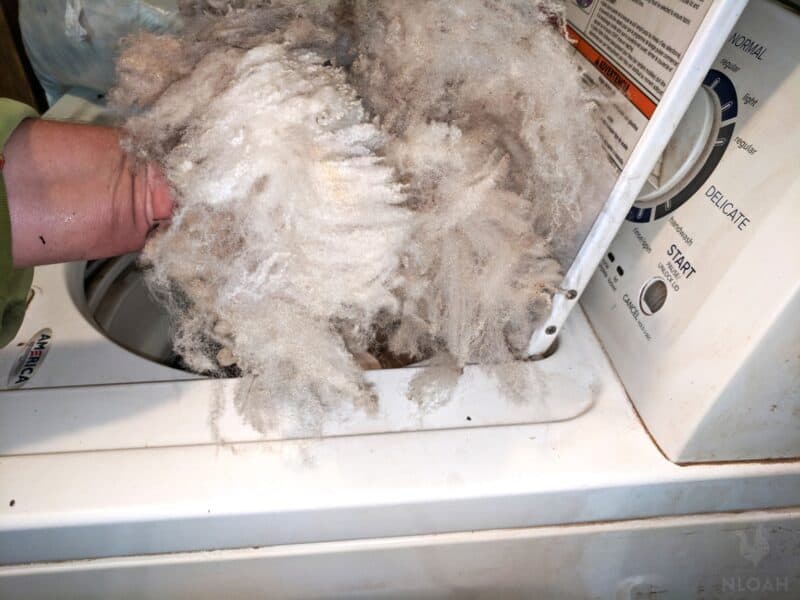
If you’re concerned about snagging, you can put the wool inside a mesh bag to be safe in the wash basin, but I’ve never found this to be necessary. It’s up to you!
Step 2: Pour in 1 to 2 tablespoons of liquid dish soap. I use Blue Dawn detergent because it is a superb grease cutter, and is not abrasive.
Step 3: Either manually agitate the drum again to mix in the soap or turn on the washing machine briefly (about 30 seconds) to mix in the liquid dish soap.
Step 4: Load up to 2 and a half pounds of raw wool into the washing machine. Push it down into the water as gently as possible. Take care not to manipulate the wool to sink it into the water any more than you have to in order to avoid wet felting.
Step 5: Allow the wool to soak in the washer for 25 minutes.
Step 6: Turn the washing machine to the rinse setting or the final spin cycle setting to drain the water from the washer.
Step 7: Pour up to three tablespoons of distilled white vinegar into the washer. If you want scented wool (some folks do this when using the raw wool stuffing) drop in up to 10 drops of your chosen essential oil as well.
Step 8: Fill the washer with warm water again, and manually agitate the drum to mix in the distilled white vinegar thoroughly. This is the process of scouring wool.
Step 9: After this second rinse, remove the scoured raw wool, and lay it out on drying racks (baking rack, old but clean screen, or dog cage panels all work well) or a towel to dry.
Directions for Small Batch Raw Wool Cleaning
- Fill the sink with warm water – just enough to cover the amount of wool you are washing and still allow it to move freely in the water. If you have a double sink, you could use one for the first stage of the scouring process and one for the second, or simply drain and refill a single sink, as I did. Two sinks speeds up the short process a bit, but then the time you save is basically wasted because you have a second sink to clean when you are done with the wool washing project.
- Pour in about 1 tablespoon of liquid dish soap. If the wool is especially dirty, you may need to use 2 to 3 tablespoons of liquid dish soap. If the raw fleece is really greasy, consider using Wisk instead. The sink water will feel very slick from the soap or Wisk used and the lanolin that you are releasing from the wool. h
- Carefully immerse the raw wool in the sink water. Slowly agitate the wool around with your hands. Again, remain very careful not to manipulate it too much, and cause wet felting to occur. You do not want to move the wool so much that you create soap suds.
- Allow the wool to soak in the sink for at least 10 minutes to loosen the dirt thoroughly.
- Remove the wool from the sink, and gently squeeze away the excess water. DO NOT ring out the wool as you wood a dish towel, or needle felting will almost certainly happen.
- Fill the sink up with warm water again.
- Pour in up to three tablespoons of distilled white vinegar.
- Agitate the water with your hands or a spoon to mix in the vinegar.
- Place the wool back into the water, and gently immerse every last bit of it.
- Allow the wool to remain in the vinegar, and water bath for at least 10 minutes. Do not agitate the wool.
- Remove the wool, and begin dying immediately while it is still wet or place it on a towel or rack to dry for one to three days before storing for future use.
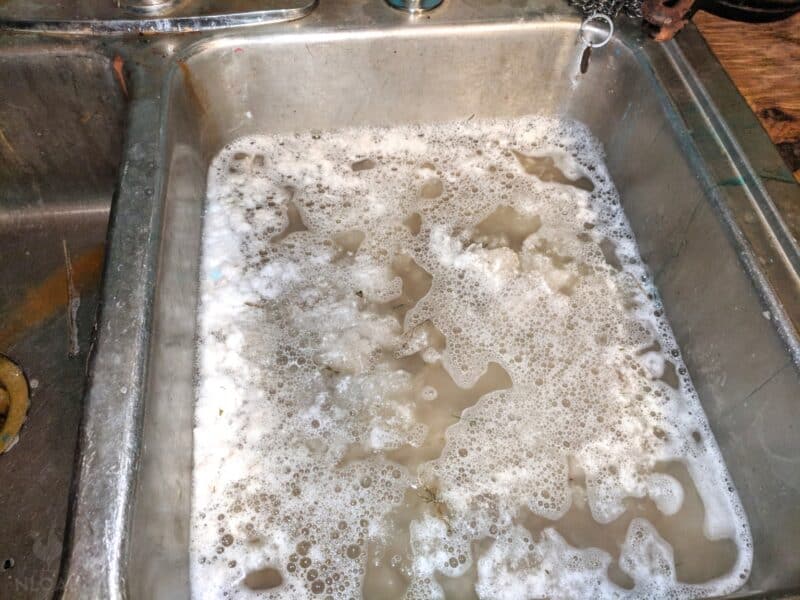
Recommendations for How to Dry Wool (and Do You Need To?)
If you are going to store the wool to use later to either make doll heads, as stuffing for plush toys or pillows, or weigh it and put it in bags to sell, the wool must be 100% dry. The drying process takes between one to three days, depending on the temperature and humidity in the drying area.
Again, as mentioned earlier, all you need to do in order to dry the wool is to lay it out to air dry. This should go without saying, but please don’t put the wool in a dryer!
It’s an incredibly delicate material, and just as you wouldn’t put wool garments (like wool sweaters, wool blankets, or another material) in the dryer, don’t do it with raw wool, either.
If the washed wool is going to be dyed, you absolutely do not want to dry it. Wool dries quickly, and must be still wet to accept either a natural or synthetic dye.
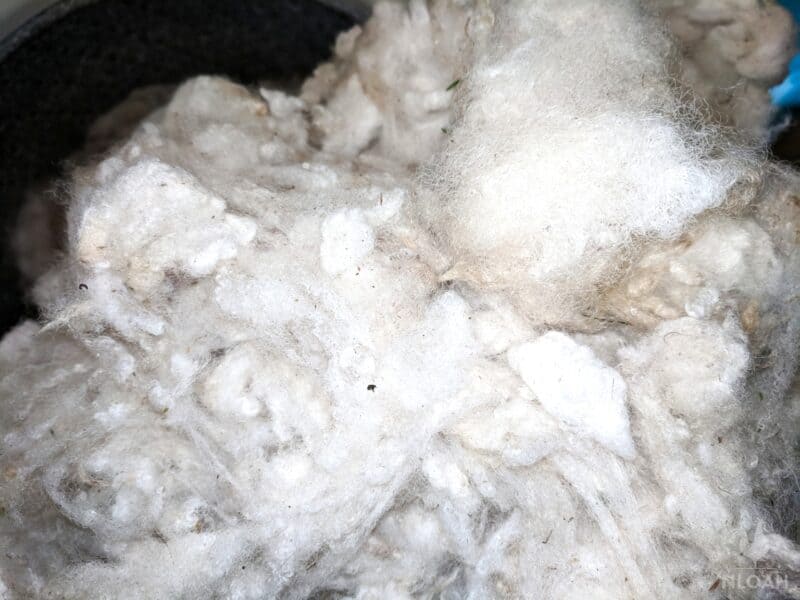
You can also follow these same steps to wash wool in large batches using a plastic tub. You will simply have to carefully do all of the agitation and fill the tub with warm water manually.
After drying the wool, picking straw, hay, and grass or other large debris out of the washed wool is almost always necessary – no matter how much time you spend doing the same thing before washing the wool. This will prevent stains and keep the wool looking nice long term.
Little bits of straw and grass will work their way out of dense wool during the scouring process, only revealing themselves as the sheep fleece dries.
What Can I Do With Unusable Wool?
One of the best things to do with unusable wool from a sheep that is impossible to clean is to repurpose it into something else altogether. Many crafters have created amazing artwork with felted wool.
From wall hangings and rugs, to figures and sculptures – there are tons of possibilities when it comes to turning unusable wool into works of art. You can also repurpose it into fabrics or other craft materials such as stuffing or batting.
One of my favorite uses for non-washable wool is simply to compost it. Sheep wool makes an amazing fertilizer that will pay off in dividends for your garden!
Storage Tips for Dry Wool
It is important to store the wool in a room that is dry, has low humidity and ideally dark, free from direct sunlight which causes bleaching and fading of the raw materials. To preserve the natural quality of the wool, it is also necessary to use an acid-free storage box or archival envelope such as tin-free unbuffered tissue paper.
This will provide a protective barrier for your wool pieces long after you’ve tucked them away in your storage box or envelope.
Have you ever washed your own wool? Are you considering it? Be sure to pin this article on one of your Pinterest boards, to come back to it in the future!
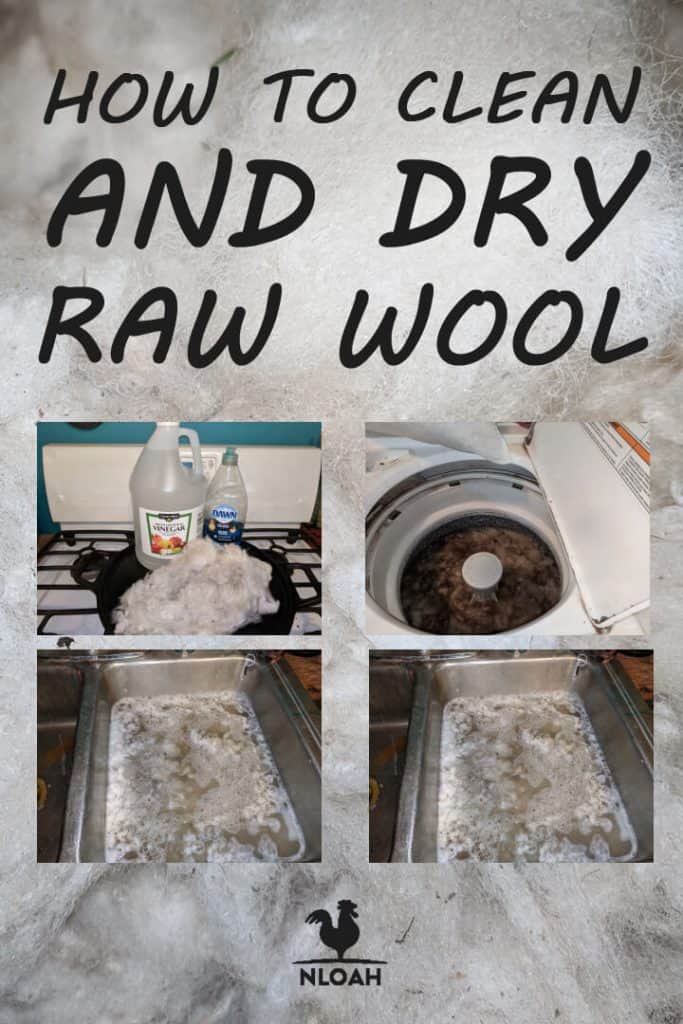

Tara lives on a 56 acres farm in the Appalachian Mountains, where she faces homesteading and farming challenges every single day, raising chickens, goats, horses, and tons of vegetables. She’s an expert in all sorts of homesteading skills such as hide tanning, doll making, tree tapping, and many more.

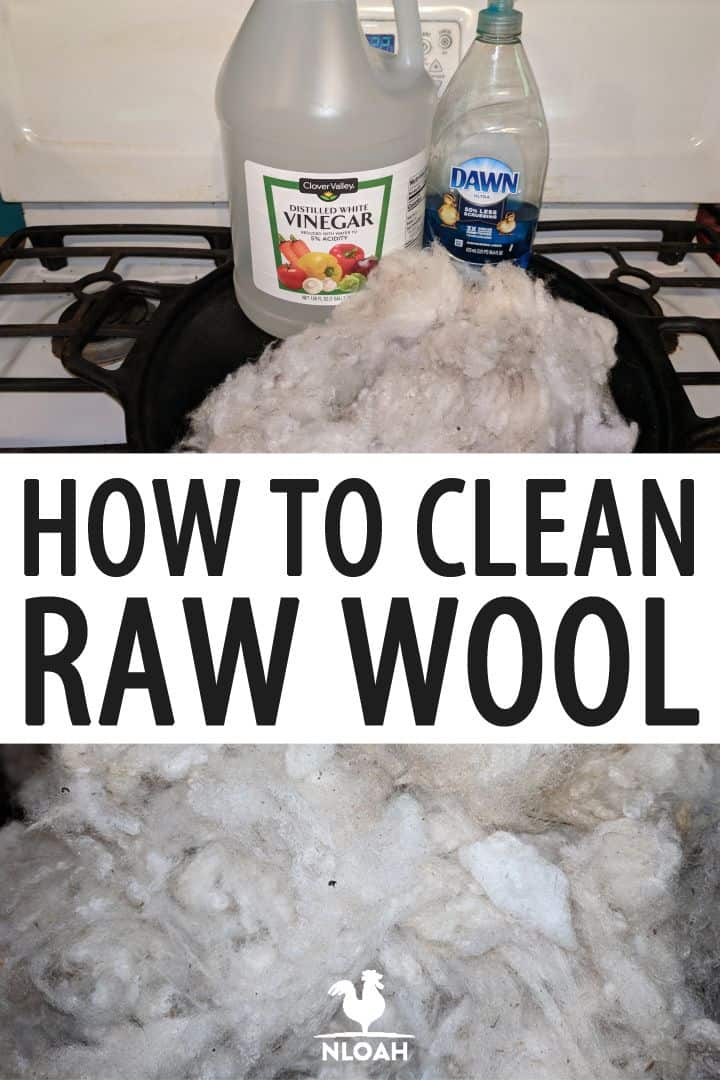
Brought home small batch of just shorn wool. Will do my best with these directions. Thank you.
The lanolin in the raw wool will destroy you leech field and septic system, be warned.
If dyeing the wool, actually it needs to be dry in order to be weighed (if you want predictable/repeatable color). When making up your dye pot, you take into account the (dry) weight of the materials to be dyed.
Once weighed, it can be soaked and made ready for dyeing.
Hi Tara, thank you for this information. Is the cleaned, dry wool then ready to use for stuffing dolls?